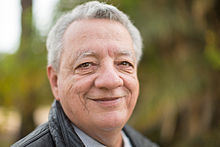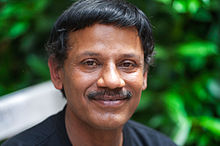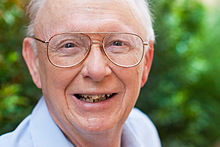Welcome to Wikipedia (Bookshelf)/2013 edition/text/zh-hant
To produce a print version in your language, please see the localization guide for Editing Wikipedia.
- See also: wikisource:Editing Wikipedia

p. 1: Front cover
Concept: A Wikipedia editor (TBD)'s photograph accompanies the entire brochure and offers guidance and explains concepts. This editor should be a local community member from the language Wikipedia in which the brochure is translated (so an English Wikipedian for English, an Arabic Wikipedian for Arabic, etc.).
編輯維基百科

A guide to improving content on the online encyclopedia

Note: reason for contributing can change based on which editor we use's actual reasons for contributing.
p. 2: Intro (inside cover)

想像一個所有人類可以自由的分享所有知識的世界,是我們的承諾。
This is the vision for Wikipedia and the other Wikimedia projects, which volunteers from around the world have been building since 2001. Bringing together the sum of all human knowledge requires the knowledge of many humans — including yours!
你可以學到些什麼?
這份指南會帶著您了解如何在維基百科上做出貢獻,因此您的知識便可以自由的分享給其他人,您將可以找到:
- 什麼是維基百科及它如何運作?
- 如何使用維基百科?
- 您如何對維基百科做出貢獻及為何您該這麼做?
- 維持維基百科運作的重要政策
- 如何使用VisualEditor和wiki markup編輯維基百科
- 一份如何添加內容的操作指南
- 與其他貢獻者互動的基本禮儀
Shortcuts
Want to see up-to-date statistics about Wikipedia? Type WP:STATS into the search bar as pictured here.

The text WP:STATS is what's known on Wikipedia as a shortcut. You can type shortcuts like this into the search bar to pull up specific pages.
In this brochure, we designate shortcuts as | shortcut WP:STATS.
p. 3: What is Wikipedia? / free content
什麼是維基百科?
維基百科-一個任何人都可以編輯的免費百科全書-是人類史上最巨大的共同計畫之一。數以百萬計的條目以上百種語言書寫而成,維基百科是成千上萬人類隨時可以閱讀的百科全書。
非常多的內容已經存在在維基百科,但是許多重要的條目內容貧乏,有些甚至沒有內容。維基百科依賴如同您一般的貢獻者維持內容的正確性、擴充子標題的內容,以及創建依您的語言增加的新的條目與內容。您所貢獻的內容讓維基百科得以成為全世界成千上萬,甚至數以百萬計人類的明燈。
當您在維基百科上編輯時,您便加入了一個成千上萬人組成的社群,成為維基人,免費貢獻自己知識給維基百科的一份子。維基人正在做的事可能改變這個世界。但是在我們海納人類所有知識前,仍有非常長的路需要走。這也是為何我們急需您的幫助。

為何要編輯維基百科?

我們想要一個更加開放、更加睿智、更加自由的世界。在那裡,人人都可以通過尋找,得到想要的知識。
如果您的內容是準確的並且經過縝密的書寫,它將每天被無數的人們所閱讀。(如果不是,它也將很快的消失。)
pp. 4-5: the Wikipedia interface / navigation
[this two-page spread is a large article screenshot, with callouts highlighting important elements of the interface]
Navigating Wikipedia pages
As you get started, it's helpful to familiarize yourself with the interface and how to navigate Wikipedia pages.

Featured content
Here you can find some of the best work on Wikipedia: articles, photographs and other content that meet the community's highest standards.
Help
The Help pages, just like the articles, are written by Wikipedia contributors.
Community portal
The community portal lets you explore what's going on across Wikipedia, from news to collaborations to policy discussions.
工具
This section has useful tools for getting more information about a page and its history.
語言
These are the other language versions of Wikipedia — out of more than 280 — that have an article on the same topic.
Language settings
These settings allow you to change the language used for menus and select your keyboard layout.
Talk
Each article has a corresponding Talk page where contributors can leave comments and suggestions, discuss changes, and ask for help from one another.
Edit
Many readers never notice the Edit button, but it's the most important part of any Wikipedia article. Click the Edit button at the top to edit the whole article, or click one of the inline links to edit a particular section.
View history
The history of a Wikipedia article includes every contribution since it was created. You can see who changed what when, and compare any two versions side-by-side.
Create account
If you haven't done so yet, create your account. With an account, you can keep track of your contributions, create a personal User page, and receive Notifications when other contributors reply to you or build on what you've done.
Search
Find articles by name, or find pages that include your search terms. You can also enter shortcuts (like "WP:HELP") to bring up specific pages that we reference throughout this brochure. A useful one is | shortcut WP:HELP.
p. 6-7: Contributors / ways of contributing /why to contribute
[This page is intended as a visual representation of the variety of ways different people contribute, why they contribute, and the diversity of contributors]
What Wikipedians do
Volunteers contribute in more ways than one. Here are examples of what it takes to make Wikipedia happen.
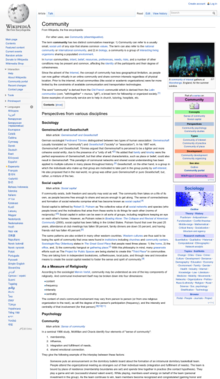

Why edit Wikipedia?

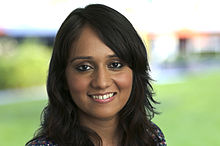
p. 8: Preparing to edit / content rules
Preparing to edit
Anyone can edit Wikipedia, but there are some basic rules. Here are some of the most important ones to follow as you start editing:
Neutral point of view
Everything on Wikipedia must be written from a neutral point of view. Articles must not take sides, but instead should describe — accurately and without bias — all the significant viewpoints on the topic published in reliable sources. Argumentation or advocacy does not belong in Wikipedia articles.
No original research
Simply put, Wikipedia is not a place to publish original ideas. Rather, you should summarize what others have published in reliable sources about the topic. Articles may not contain any new analysis, and they should not synthesize published materials to reach broader conclusions beyond what the individual sources say.
Copyright and plagiarism
Since all contributions are freely licensed, no editor owns any article; all of your contributions can and will be edited and redistributed. Except for brief quotations, copying content from copyrighted sources onto Wikipedia is not allowed. Whether direct copying or close paraphrasing, plagiarism and copyright violation are disruptive and time-consuming for volunteers to clean up. It’s important that all content you contribute to Wikipedia is written in your own words. (Public domain and freely licensed content may also be added to Wikipedia as long as it is properly attributed.)
Reliable sources
Information in Wikipedia needs to be verifiable, based on reliable published sources. You should include citations for the information you add to the encyclopedia, so that others can check it for themselves. The most reliable sources for Wikipedia are third-party sources with a reputation for fact-checking, such as books published by academic presses, peer-reviewed academic journals, and international newspapers. You should be using sources that represent significant viewpoints, rather than one-off studies or fringe work. Try to find the best and most reliable sources available on the topic.
Conflicts of interest
If you have a conflict of interest about a particular topic — such as an employer or an organization you are a part of — you should avoid editing articles about it.

P. 9 Encyclopedic Writing Style
What is encyclopedic style?
Writing in an encyclopedic style and a formal tone is important when adding new content to Wikipedia. Instead of essay-like, argumentative, or opinionated writing, Wikipedia articles should have a straightforward, just-the-facts style. Here are examples of the do’s and don’ts of encyclopedic writing.
Inappropriate
Britannica and the Future of Encyclopedias
| “ | {{{2}}} | ” |
What to avoid
Don’t create new essay-like articles or sections.
Don’t structure your writing as an argument.
Don’t use “weasel words” (like “most experts agree” or “some people say”).
Don’t use colloquial language or slang.
Don’t use “peacock terms” (like “great”, “extraordinary”, or “intrepid”).
Don’t inject personal opinion into the writing.
Don’t use overly complex language and sentence structure.
Appropriate
| “ | {{{2}}} | ” |
Do
Use plain language
Be brief
Cite sources to back up factual claims
Attribute viewpoints to the people who hold them
Avoid stating conclusions, except when attributed to a specific source
p. 10: VisualEditor / structure of an article
[This page and the following page show edit mode for the same article in VisualEditor and wikitext, respectively. The VisualEditor side focuses on the structure of a typical article, while the wikitext side shows the wikicode syntax for typical page elements.




Editing with VisualEditor
With VisualEditor, you can see what your changes will look like as you edit, so you can focus on the content. Just click on the parts you want to change and start editing.
Editing toolbar
In edit mode, the toolbar lets you add formatting, references, images, and special page elements called templates (such as the infoboxes at the beginning of many articles). When you are finished editing, press the "Save page" button.
Lead section
The first sentence provides a definition of the topic, and the lead section goes on to summarize the key points covered in the article. This is the only section without a heading.
Images
Freely licensed images and other media files can be added to Wikipedia articles from Wikimedia Commons.
Citations
Inline citations in the body of the article are used to show where the information in each part of the text came from. The citation details appear as footnotes at the end.
Templates
Reusable pieces called templates are used to format information in standard ways, and to insert things like the banners that alert readers to problems with an article.
Body of the article
Headings — and sometimes sub-headings — break the article up into sections, and are used to generate the table of contents. Each section usually covers some significant aspect of the topic, so that readers can jump right to the information they are looking for.
Appendices and footnotes
After the main body of an article come sections with additional information, such as related Wikipedia articles ("See also"), footnotes with details on the sources used ("References"), and a list of other websites readers could turn to for more information ("External links").
p. 11: Wiki markup
[This page consists of a simplified and excerpted version of the wiki markup for the same article as on the facing page. Most of the content is blurred out, but the example elements of markup are not. Callouts explain the most import markup syntax.]






Editing with wiki markup
Wiki markup is the original form of editing Wikipedia articles (and on some browsers, it will be the only form available). It gives you precise control over the content and appearance of the page, once you understand how it works. Some of the underlying wiki markup for an article is pictured below. See how many of the corresponding elements you can find in the VisualEditor illustration.
Image
Double square brackets around the title of a photo from Wikimedia Commons will insert the image. Pipes separate optional parameters to control how the image is displayed. The most common way is with two parameters: the word “thumb” to use the standard thumbnail format, and a descriptive caption that appears beneath the image.
[[File:Example.jpg|thumb|caption]]
Bold
Three single quotation marks before and after a string of text makes that text bold. The article’s subject is usually bolded in the first sentence.
'''bold text'''
Citation
Opening and closing ref tags are used to cite a source. An automatically-numbered superscript appears at the location of the ref tags, and the content appears as a footnote in the references section.
<ref> citation text </ref>
Internal link
Double square brackets around a term create a link to the article of that name. Adding a pipe and another string of text before the closing square brackets changes the link text.
[[article title|text]]
Italic
Two single quotation marks begin and end a segment of italic text.
''italic text''
Heading
A pair of double equals signs mark a line as a heading. Triple equals signs make a sub-heading.
==Heading==
Template
Double braces are used for templates, which are reusable page elements that serve many purposes. The first item after the opening braces is the template’s name. Pipes separate the parameters, which are additional inputs that can change the way the template works or what it displays.
{{template name|parameter}}
References
The references tag, or an equivalent template, sets the location where the footnotes show up — typically in a “Notes” or “References” section.
<references />
External link
A single square bracket, followed by a URL, a space, label text, and a closing square bracket makes a normal hyperlink. Typically, they are only used in footnotes or an “External links” section.
[http://www.example.com text]
Category
At the end of an article, double square brackets around a string that starts with Category: adds an article to the specified category. Categories organize Wikipedia articles into related sets.
[[Category:Something]]
For more wiki markup help, see the cheatsheet on page 19 or visit the reference page | shortcut WP:MARKUP.
pp. 12-13: Adding content, step by step
Adding content, step by step
These images show how one contributor added new information to the article on Penny Cyclopaedia.
The article before editing...

...and the article after changes were saved.

This image shows what the contributor added and the markup they used. Follow these steps and you too can add content to a Wikipedia article.
Step 1: Pick a topic you want to write more about.
Step 2: Find a reliable source that covers the topic better than the current Wikipedia article.
Step 3: Now comes the fun part. Click the Edit button!
Step 4: Add some of what is missing. Using the source you’ve found, summarize the information you want to add in your own words.
Step 5: At the end of your new block of text, add a reference. In the edit toolbar — whether you’re using wiki markup or VisualEditor — you can click the ‘cite’ icon to cite your source.
Step 6: In the ‘edit summary’ field, add a brief description of what you’ve done in your edit.
(With VisualEditor, you’ll be prompted for an edit summary after you click Save page.) The edit summary helps other editors understand what you are doing.
Step 7: Now it’s time to save your changes. Be sure to click Save page.

Don’t worry. If you make a mistake, you can always make more changes or restore a previous version of the article.
p. 14: Interacting / user pages / user talk
User pages and Talk pages
Wikipedia has other types of pages beyond articles. As you start editing, you might also want to create your User page to let others get to know you a little bit.

At the top right (if you are logged in) you will see your username, which you can click to reach your User page. Links to pages that do not exist — such as your User page if you have not created it yet — are colored red, instead of the typical blue.

If you click the Create button on one of these pages, you can start from a blank page. A User page is a place to write a little bit about yourself, to give other contributors an idea of who you are and what you’re interested in. You can share as much or as little as you like.
When you Save the page, your red link will turn blue!

You also have a User Talk page, where other contributors can leave messages for you. If you want to contact another contributor, you can navigate to their Talk page and leave a message at the bottom.
You should sign your messages on Talk pages; clicking the Signature button in the edit toolbar will insert four tildes ( ~ ~ ~ ~ ), the special wiki markup for inserting your username along with the date and time of your message.

This icon on the edit toolbar is the Signature button
p. 15: article talk / etiquette
Interacting with the community
Every article has its own Talk page, too. These Talk pages can be used to make suggestions, post new sources, point out problems, and discuss changes that contributors disagree about.
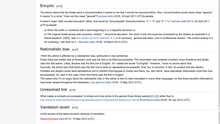


One important guideline for community discussions on Wikipedia is to be respectful and civil. Even if you get into disagreements, you should assume good faith on the part of other contributors. They almost always have the same goal you do — to make Wikipedia better. Keep the discussions focused on content, rather than making them about individual contributors.
p. 16 mobile editing
Mobile editing
In addition to the traditional desktop interface, Wikipedia has a streamlined mobile version that you can use to both read and edit. Just visit Wikipedia on your smartphone or tablet, then log in.

Show and hide menu options

Edit articles
Upload and add photos
Add articles to your watchlist
Check your Notifications
Why edit Wikipedia?


p. 17 more about English Wikipedia
[The idea is that this is a page with a pretty simple layout that can be rewritten for each language to highlight whatever is important for that version of Wikipedia that isn't already covered.)
More about English Wikipedia
Each language version of Wikipedia is different (although there is a lot in common across languages as well). These are some of the things specific to English Wikipedia that you may find useful.
Creating your first article
Starting a new article on English Wikipedia — and making sure it doesn’t get deleted — can be tricky. For a detailed guide on creating your first article, see | shortcut WP:FIRST .
Wikipedia Signpost
The Signpost | shortcut WP:SIGNPOST is a weekly community newspaper, covering Wikipedia-related news and research, important discussions, new Featured content, and more. You can even subscribe to have it delivered to your Talk page each week.

Uploading non-free images
In general, only freely licensed or public domain images can be used to illustrate Wikipedia articles, and these should be uploaded to Wikimedia Commons (commons.wikimedia.org). However, limited exceptions are allowed on English Wikipedia under the non-free content rules | shortcut WP:NONFREE for things like album covers. Non-free images uploaded to Wikipedia without a clear justification under the rules will be deleted.

WikiProjects
WikiProjects are groups of contributors who have a common interest when it comes to editing Wikipedia. Browsing the existing WikiProjects | shortcut WP:WIKIPROJECT and joining ones that interest you can be a good way to find things you want to work on and connect with other Wikipedians.
[WikiProject Directory image]
Wikipedia 1.0 assessments
WikiProjects on English Wikipedia have a system for rating the quality and importance of articles, known as the Wikipedia 1.0 assessments | shortcut WP:ASSESS . For quality, these ratings go from Stub (just the beginnings of an article) to Start to C-class to B-class, and then the formally reviewed ratings of Good article, A-class, and Featured article.
You can see the ratings for an article at the top of its Talk page, and most WikiProjects maintain a table showing how many articles related to that WikiProject have each rating. Browsing WikiProjects for Stub and Start articles is a good way to find new topics to work on.
p. 18: article quality / additional resources
Evaluating Wikipedia article quality
The quality of Wikipedia articles varies widely; many are very good, but some lack depth and clarity, contain bias, or are out of date. In general, high-quality articles have these elements:
- a lead section that gives an easy-to-understand overview,
- a clear structure,
- balanced coverage,
- neutral content, and
- reliable sources.
Additional information about article quality is available by consulting the “Evaluating Wikipedia” brochure (see below).
Additional resources
Evaluating Wikipedia: Tracing the evolution and evaluating the quality of articles"
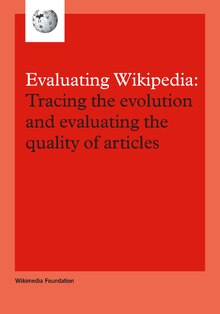
How articles evolve, elements of good quality articles, and signs of poor quality articles are all covered in this guide.
Illustrating Wikipedia: A guide to contributing content to Wikimedia Commons

A companion guide covering Wikimedia Commons, the media repository for images used on Wikipedia. The brochure covers what Wikimedia Commons is, how to upload files, how to use files, and the basics of free licenses.
Instructor Basics: How to use Wikipedia as a teaching tool

This brochure offers best practices for educators looking to assign students to contribute to Wikipedia as part of their course curriculum.
p. 19: wiki markup cheatsheet
Wiki markup cheatsheet
These examples cover the formatting needed most often when editing Wikipedia articles with wiki markup. For more help, see | shortcut H:MARKUP .
Description
What you type
What you get
Italic
italic text
Bold
bold text
Section headers
Heading text
Link to another Wikipedia page (Internal link)
Denis Diderot
Internal link with different text
Link to another website
Bulleted list
- Wikipedia
- Encyclopédie
Numbered list
- A - Azymites
- B - Cézimbra
Image with caption
[[File:Example.jpg|thumb|Caption text]]
Caption text
Signature and timestamp (for Talk pages)
~~~~
Username (talk) 19:50, 11 December 2013 (UTC)
To make a citation
What you type
What you get
Insert a citation
Page text. <ref>[http://example.org Example.org], more text.</ref>
Page text.[1]
Display citation footnotes
<references />
1. ^ Example.org, more text.
p. 20: back cover / glossary
edit summary
A brief explanation of an edit to a Wikipedia page, which helps other contributors follow the development an article and understand the intention of the edit.
free license
A public copyright license that ensures the freedom to use and study a work, to make and redistribute copies of it, to make changes and improvements, and to distribute derivative works, by any person for any purpose. Wikipedia — and each individual contribution to it — uses the Creative Commons Attribution-ShareAlike license, which is a free license. See | shortcut WP:CC-BY-SA to learn more.
history
The record of a Wikipedia page, accessible through the View history tab, that shows every edit made. Any two versions can be compared to see the specific differences (known as a diff), and previous versions can be restored.
markup
The special code used to format a Wikipedia page. See the cheatsheet (page 19) for the basics, or go to | shortcut H:MARKUP for more detail.
Notification
A message for you that shows up at the top of a Wikipedia page. If you want to let someone know you replied to them, you can create a Mention Notification by including a link to their User page in a signed Talk page message.
parameter
A bit of text, separated from other bits with a pipe character (|), that is used to control how images, templates, and other wiki markup appear on a page.
stub
A short, undeveloped article with plenty of room for expansion. Adding content to stubs is a good way for new contributors to get started.
Talk page
The discussion space for an article or other Wikipedia page, where you can talk about the contents of the page with other contributors.
templates
A way of automatically including the contents of one page within another. For instructions on using them, see | shortcut H:T .
User page
The personal page of an individual contributor, which begins with "User:" followed by their username. Wikipedians can use their User pages to share information about themselves and their interests, list the articles they have worked on or want to work on, and much more.
Wikimedia Commons
The media repository for Wikipedia and many other wikis, where you can contribute freely licensed photos, diagrams, videos, and other media files for illustrating Wikipedia.
Wikipedian
Someone who helps build Wikipedia. Commons synonyms include contributor, user, editor, and community member.
All images from Wikimedia Commons are under a CC BY-SA license or public domain unless otherwise stated. The content contained within is available under the Creative Commons Attribution-ShareAlike License v.3.0 (http://en.wikipedia.org/wiki/Wikipedia:CC-BY-SA) or any later version.

The trademarks and logos of the Wikimedia Foundation and any other organization are not included under the terms of this Creative Commons license. Wikimedia Foundation, Wikipedia, Wikimedia Commons, MediaWiki, Wiktionary, Wikibooks, Wikidata, Wikisource, Wikinews, Wikiquote, Wikiversity, Wikivoyage, Wikispecies, and Meta-Wiki are pending trademark registration or are registered trademarks of Wikimedia Foundation.
For more information, please see our Trademark Policy page, http://wikimediafoundation.org/wiki/Trademark_Policy.
For other questions about our licensing terms or trademark policy, please email legal@wikimedia.org
Design by David Peters, EXBROOK
Portraits of Wikipedians by Karen Sayre, Adam Novak, and Victor Grigas. CC BY-SA 3.0



